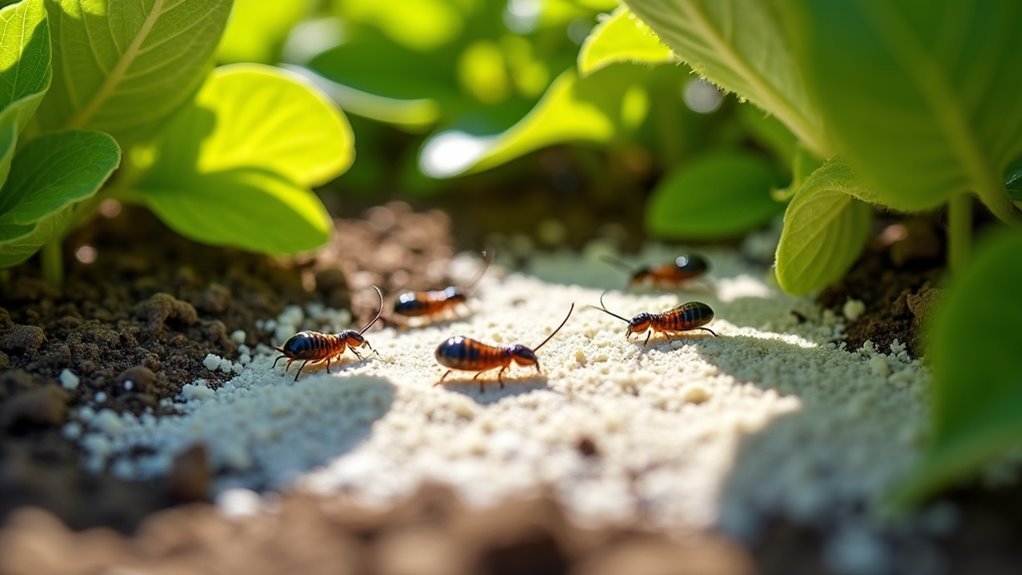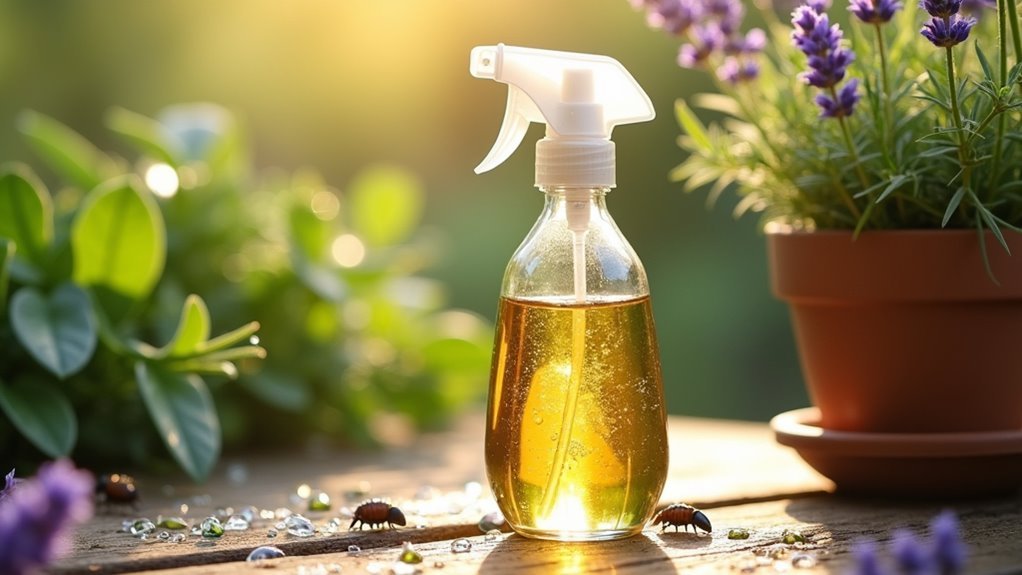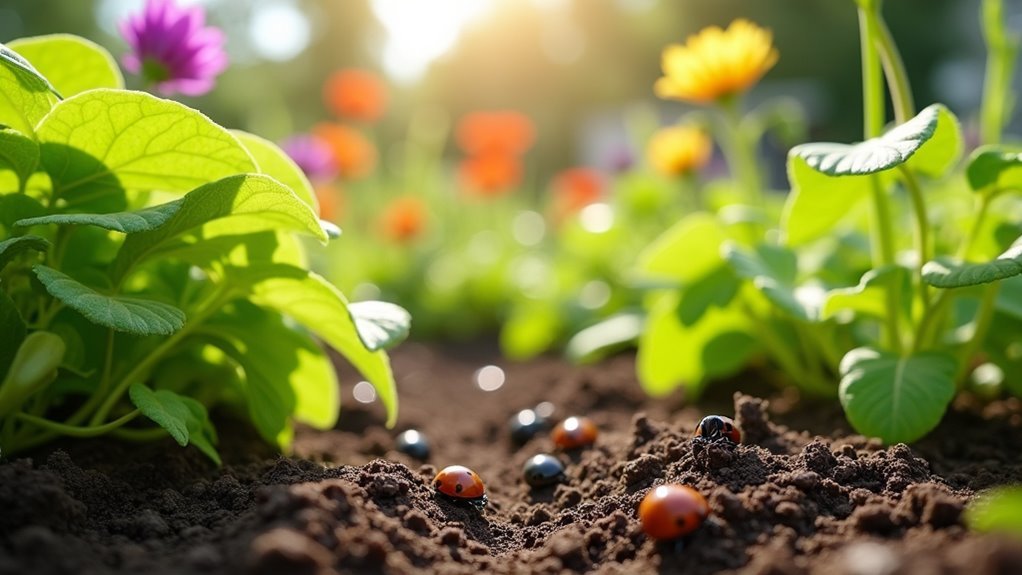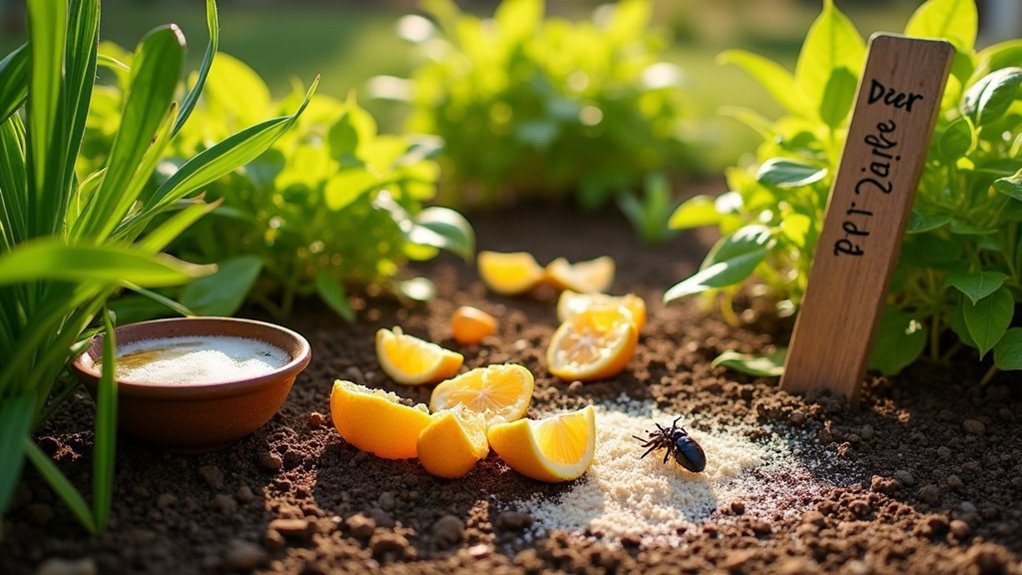You can eliminate earwigs safely by sprinkling diatomaceous earth around hiding spots, setting beer or soy sauce traps near affected plants, and creating essential oil spray barriers with peppermint or citrus oils. Deploy rolled newspaper traps in damp areas, encourage natural predators like birds and toads, remove moisture sources while sealing entry points, and apply soapy water solutions directly on earwigs. These natural methods effectively target nocturnal pests without endangering your furry companions, and there’s much more to discover about each technique.
Use Diatomaceous Earth Around Problem Areas

When earwigs invade your garden or home, diatomaceous earth offers a pet-safe solution that eliminates these pests without toxic chemicals. This naturally occurring powder cuts through earwig exoskeletons, causing dehydration and death while remaining completely safe for your furry friends.
Sprinkle a thin layer of Diatomaceous Earth in earwig hiding spots like under debris, around flower beds, and garden borders. You’ll see significant population reduction without harming beneficial insects when used sparingly, making it an excellent eco-friendly pest control option.
A 3lb bag covers substantial areas and treats most infestations effectively. Remember to reapply after heavy rain or watering since moisture diminishes its effectiveness.
This simple approach provides reliable results while protecting both your pets and garden ecosystem.
Set Up Beer and Soy Sauce Traps
While diatomaceous earth works through direct contact, beer and soy sauce traps offer another effective pet-safe approach by luring earwigs to their demise.
Beer and soy sauce traps provide a chemical-free solution that attracts earwigs without endangering your furry family members.
You’ll create beer traps by burying shallow containers filled with beer near affected plants. The earwigs crawl in and drown in the liquid.
For soy sauce traps, you’ll mix equal parts vegetable oil and soy sauce in small containers with holes punched in the lids. The earwigs enter through the holes and drown in the oil mixture.
Both methods are completely pet-friendly since they don’t use harmful chemicals to eliminate pests.
Replace the beer or soy sauce regularly to maintain effectiveness. Always dispose of traps away from your garden to prevent attracting more earwigs back.
Create Essential Oil Spray Barriers

Essential oils provide a natural, aromatic barrier that effectively repels earwigs while keeping your pets completely safe from harmful chemicals.
You’ll want to mix 10-15 drops of peppermint, lavender, or citrus essential oils with 2 cups of water in a spray bottle. Apply this mixture around entry points and infested areas where earwigs typically hide.
For maximum effectiveness, spray the solution in the evening when earwigs are most active. The oils create a scent barrier that drives these nocturnal pests away while leaving your home smelling fresh.
You’ll need to reapply regularly, especially after rain or watering, since the oils dissipate over time. This dual-purpose solution manages pest control while maintaining a pleasant environment for your family and pets.
Deploy Rolled Newspaper and Cardboard Traps
You can create effective earwig traps using simple household materials like rolled newspaper and cardboard pieces.
These non-toxic traps work by providing dark, moist hiding spots that naturally attract earwigs overnight.
Proper setup and timely collection guarantee you’ll capture these pests without risking your pets’ safety.
Setup and Placement
Since earwigs seek out dark, damp hiding spots during daylight hours, positioning your traps strategically will maximize their effectiveness.
Focus your setup on areas where earwigs frequently gather, such as under potted plants, along foundation walls, or near garden beds with dense vegetation. Place your dampened newspaper rolls and cardboard traps in these shadowy, moisture-rich locations where pets won’t disturb them.
Check your traps every morning to remove captured earwigs and assess their condition.
Replace deteriorating materials promptly to prevent decomposition from attracting unwanted pests. This consistent monitoring routine is essential for maintaining a healthy, earwig-free environment around your home.
Always dispose of used traps and captured insects away from your garden to prevent re-infestation.
Collection and Disposal
Once your traps have spent the night attracting earwigs, you’ll need to collect and dispose of them properly to complete the elimination process.
Check your damp newspaper rolls and cardboard strips early in the morning when earwigs are still hiding inside. Carefully pick up each trap and shake the captured insects into a bucket or bag.
These trapping methods remain safe for pets throughout the collection process since you’re only handling physical materials without chemicals.
For disposal, take the collected earwigs far away from your garden area to prevent them from returning. You can dispose of them in your regular trash or release them in a distant location.
Replace your traps with fresh, damp materials to maintain effectiveness and continue protecting your garden.
Encourage Natural Predators in Your Garden

You can harness nature’s own pest control system by encouraging natural predators that feast on earwigs in your garden.
Birds, toads, and ground beetles are excellent allies in this battle, as they actively hunt earwigs and their larvae throughout your outdoor space.
Creating the right conditions to attract and support these beneficial creatures will establish a sustainable, pet-safe approach to managing earwig populations.
Attract Beneficial Birds
While chemical pesticides might seem like a quick fix for earwig problems, attracting beneficial birds to your garden offers a natural, pet-safe solution that creates lasting ecosystem balance.
To attract beneficial birds that’ll tackle your pest problem, plant sunflowers, berry-bearing shrubs, and native flora. These natural repellents work by supporting birds like wrens and sparrows that actively hunt earwigs.
Install birdhouses and feeders to provide shelter and food sources, making your garden more appealing to these effective control methods. Add a shallow birdbath for drinking and bathing opportunities.
Regular maintenance of these features guarantees they remain functional and attractive to birds. By avoiding chemical pesticides, you’ll maintain a safe environment for both your pets and beneficial predators, creating sustainable earwig management.
Create Toad Habitats
Beyond feathered allies, toads represent another powerful weapon in your pet-safe arsenal against earwigs. These natural predators can dramatically reduce earwig populations without harming your furry companions.
| Habitat Element | Purpose | Implementation |
|---|---|---|
| Water Sources | Provide drinking water and moisture | Place shallow ponds or dishes in shaded areas |
| Shelter Options | Offer hiding spots and safety | Add rocks, logs, or brush piles throughout garden |
| Food Sources | Support diverse insect populations | Plant native vegetation for balanced ecosystem |
You’ll want to install toad houses using clay pots or wooden boxes for additional refuge. This thorough pest management strategy creates an ecosystem where toads thrive while naturally controlling earwig infestations. The result? A safer garden environment for both your pets and plants.
Support Ground Beetles
Ground beetles patrol your garden like tiny armored tanks, devouring earwigs and their larvae with remarkable efficiency.
These natural predators can considerably reduce pest populations when you create the right environment for them.
Establish beetle-friendly habitats by spreading mulch, leaf litter, or small rocks around your garden.
These materials provide essential shelter and breeding grounds.
Plant diverse vegetation including native flowers and herbs to supply food sources and nesting sites that’ll keep beetle populations thriving.
Skip broad-spectrum insecticides that harm these beneficial insects and disrupt your garden’s natural balance.
Instead, maintain a healthy ecosystem by minimizing soil disturbance and encouraging plant variety.
When you support ground beetles, you’re creating a sustainable solution that’ll eliminate pests naturally while keeping your pets safe.
Remove Moisture Sources and Seal Entry Points
Since earwigs are drawn to moisture like magnets, you’ll need to eliminate damp conditions throughout your home to make it less appealing to these pests. Start by fixing leaky pipes, faucets, and drains immediately. These moist environments provide perfect breeding grounds for earwigs.
| Area | Action Required | Frequency |
|---|---|---|
| Plumbing | Fix leaks promptly | As needed |
| Gutters | Clean and unclog | Monthly |
| Foundation | Remove debris piles | Weekly |
| Entry Points | Seal cracks/crevices | Seasonally |
Next, you’ll want to seal entry points using caulk or weather-stripping around windows, doors, and foundations. Install dehumidifiers in humid areas like basements and bathrooms. Clean gutters regularly to prevent water accumulation, and remove organic debris near your foundation to get rid of earwigs effectively.
Apply Soapy Water Solutions
One of the simplest yet most effective pet-friendly methods involves creating a homemade soapy water solution that kills earwigs on contact.
Mix a few drops of dish soap with warm water in a spray bottle to create this powerful deterrent. The soapy water penetrates the earwig’s waxy protective coat, causing dehydration and death when sprayed directly on the insects.
Apply this solution in areas where you’ve spotted earwigs – corners, baseboards, and around your garden plants. You’ll create an effective barrier that prevents their return to your home.
Choose plant-safe dish soaps to avoid harming vegetation, and reapply regularly after rain or watering since the soap barrier washes away, maintaining consistent protection against these unwanted pests.
Frequently Asked Questions
How Do I Get Rid of Earwigs in My House Pet Safe?
You can sprinkle diatomaceous earth in hiding spots, spray soapy water where you’ve seen them, use beer traps away from pets, or apply peppermint oil mixed with water as a natural repellent.
What’s the Best Home Remedy to Get Rid of Earwigs?
You’ll find beer traps work exceptionally well for eliminating earwigs. Simply fill shallow containers with beer and place them around your garden. The earwigs are attracted to the scent and drown overnight.
What Is the Best Earwig Deterrent?
You’ll find diatomaceous earth works as the most effective earwig deterrent since its sharp particles cause dehydration. Apply it sparingly around entry points and affected areas for best results.
What Do Earwigs Hate the Most?
Earwigs hate strong scents the most, particularly essential oils like peppermint, lavender, and citrus. You’ll find they’re also repelled by dry environments, garlic spray, and diatomaceous earth’s sharp particles.
In Summary
You’ve got seven proven methods to tackle your earwig problem without putting your pets at risk. Start with diatomaceous earth and moisture control for long-term prevention, then add traps and natural deterrents as needed. Remember, you don’t need harsh chemicals when these pet-safe alternatives work just as effectively. Stay consistent with your chosen methods, and you’ll see results within days while keeping your furry friends completely safe.





Leave a Reply